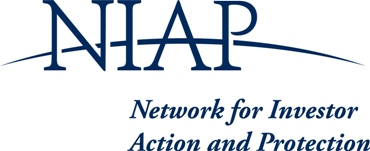UPDATE: A NOTE FOR INDIRECT INVESTORS….
Dear Friends –
With the introduction of the Garrett legislation, I wanted to take a moment to address the concerns of indirect investors who feel that NIAP has not properly supported their issues. First, we do understand your concern and request that all sides pursue a level of respectful discourse as we try to move forward on several fronts. NIAP has, and will continue to advocate for indirect investors in our lobby efforts, and the introduction of Garrett’s HR 757 legislation is only a step in a process of change in investor protection and relief. Understand, also, that this legislation, like most all legislation will go through the normal course of review and change before it is ultimately passed, and this is why we’ve invited comment.
(Comments on H.R. 757 can be emailed to us at: commentsHR757@investoraction.org)
As indicated in previous updates, and as the marker bill HR6531 introduced in December made clear, the Garrett bill’s core rationale is to reaffirm the original intent of the Congress in determining customer “net equity” and the absence of any express or implied authority in SIPA for avoidance actions against innocent customers. It is a clarification, not a material change, to existing SIPC law, and one having special urgency given the upcoming March 3 oral arguments in Appellate Court on Net Equity as well as a desire to deliver a message to the BLMIS Trustee who is pursuing clawback against, and to the obvious further trauma to innocent direct investors. These horrific actions undertaken by the Trustee are based on his callous and arbitrary redefinition of net equity and account value to suit his, and SIPC’s, needs. The assertion of final account statement valuations has been a common point of agreement among direct and indirect investors alike for quite some time and a fundamental underpinning of NIAP’s efforts.
Redefining Customer: Regarding the redefinition of “customer” for indirect investors (which would also provide indirect investors access to SIPC funds), it has been far more difficult to persuade Congressional members and staff that the Congress in 1970 or 1978 contemplated providing SIPA protection to indirects — in effect to customers of customers. I’m not saying they’re right, and we know they are clearly empathetic, but it’s another step in the process of winning them over, and needs some creative outside-the-box thinking as to how to make that leap and provide relief, whether via the SIPC fund or some other means.
SIPC Shortfall: Some are concerned that the proposed legislation might create a shortfall in SIPC funds. This should not be at issue. It is SIPC’s obligation to cure any shortfall by assessing the necessary fees, should Congress direct them to do so.
Clawback from Indirect Investors: Some indirects have also expressed concern that the proposed legislation provides no protections from clawback, or worse, discourages those protections while providing them to direct investors. Unquestionably, Congressman Garrett has no desire to see his legislation weaken clawback protections for any innocent investors – direct or indirect Moreover, for current victims of the BLMIS failure, the expiration of the Trustee’s statute of limitations for filing lawsuits would presumably prevent further action against indirect investors, even if one were not inclined to believe the Trustee’s earlier assertions that he would not be pursuing customers of feeder funds.
Recoveries of customer property. Lastly, and importantly, we think that the recoveries of customer property by the Trustee should be welcome news for indirects. Even though there are a variety of scenarios that could be key factors in how much each fund, as a “customer” receives, we imagine that indirect investors stand to obtain a substantial share of the total recoveries, which could exceed $20B or even far more, as the Trustee alleges is feasible.
What’s important for all investors is undertaking a civil and respectful approach to Congress. Criticizing the proposed legislation only serves to diminish the effectiveness of the message of indirects, and puts them in a negative light. It also makes our work on behalf of indirect investors more difficult. Instead, asking Congress to now turn some of their attention to the plight of thousands of indirect investors without criticizing HR757 increases the chances of success for indirects. Strategically targeting Congressmen in high victim districts as well as communications with key congressional leaders in a positive manner that focuses on the personal narratives of innocent investors is all important.
Even as NIAP advocates for additional relief for indirect investors, and as we’ve indicated in prior updates, additional help is needed to persuade members of Congress. NIAP cannot do this alone – indirect investors must reach out to their representatives and effectively convey their personal stories. NIAP’s lobbyists can open the door and be supportive, but the convincing really happens on a grassroots level for all legislation.
This is, and will continue to be, a long and difficult process for all, complicated by many different categories of victims. NIAP will continue to press forward, seeking pragmatic solutions within the scope of its abilities. While victims of this fraud work to build support, however, we must not tear down. I again urge all to pursue the high road in dialogue, and focus on building the changes that need to be made.
In Peace,
Ron Stein
